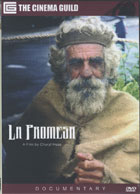
La Promesa (The Vow) 2004
Distributed by Cinema Guild, 115 West 30th Street, Suite 800, New York, NY 10001; 212-685-6242
Producer n/a
Directed by Cheryl Hess
DVD, color, 26 min.
College - Adult
Latin American Studies, Religious Studies, Sociology
Date Entered: 02/02/2007
Reviewed by Sean Patrick Knowlton, University of Colorado at BoulderLa Promesa (The Vow) is a short, visually-impacting 2004 documentary that highlights one father’s vow to make a pilgrimage each year for five years to the small Cuban town of Rincón in gratitude to Saint Lazarus, whom he credits for healing his youngest son from hydrocephalus. Beyond the father’s personal journey, this video also captures the surrounding fervor of the religious Festival of Saint Lazarus.
To Cubans who are followers of Santería, Saint Lazarus is also the syncretized Orisha deity, Babalú Ayé. Santería is the Cuban combination of Catholicism and the West African Yoruban belief system in which Babalú Ayé is a god associated with healing those afflicted with illness. To many Cubans, Saint Lazarus is plainly known as the Old Man and is one of Cuba’s most beloved saints. Each year on December 16th and 17th, thousands of pilgrims visit this small church in the province of Havana to offer their thanks or ask for a miracle. Many make the journey barefoot, on their knees, or crawling.
This film primarily documents the vow made by a construction worker of little means, Fidel Valledades, as he crawls on his back, from a greater distance each year over the course of five years, carrying his youngest son on his stomach. On his way, fellow pilgrims lighten his load by singing their encouragement and offering his family small donations. This documentary captures his fifth and final pilgrimage in repayment for Saint Lazarus’ intervention in the health of his son, Yoán.
Other pilgrims are also briefly highlighted. These include one man whose wife works as a fortune-teller in the carnival atmosphere outside of the church grounds and another woman who briefly relates her hope that her Saint Lazarus statue will help free her son from prison. One of the most moving images in this documentary is that of a barefoot man crawling through the streets dragging behind a large cinderblock chained to his ankle.
Visually, this documentary offers a rare look at one particular aspect of religious faith in Cuba. However, additional classroom instruction and discussion are recommended to bolster and provide context to the documentary as it includes little exposition on the belief systems behind this particular pilgrimage destination. Also of possible interest to viewers, but not yet viewed by this reviewer, is The Night of San Lázaro, a 35-minute documentary from 1997 on the same topic.
Eschewing direct interviews, the filmmakers, instead, frame the story developing onscreen with brief English-language subtitles (in white) that provide minimal background information. All dialogue and singing is in Spanish, which is subtitled (in yellow) in English. The sound and image quality are both very good.
Recommended for college students, adult viewers, Latin American studies programs, religious studies programs and the libraries that serve them.
Awards
- Best Documentary, Philadelphia Film Festival, 2004
- Winner, Iowa City International Documentary Film Festival, 2005
- Best Documentary, Big Muddy Film Festival, 2004